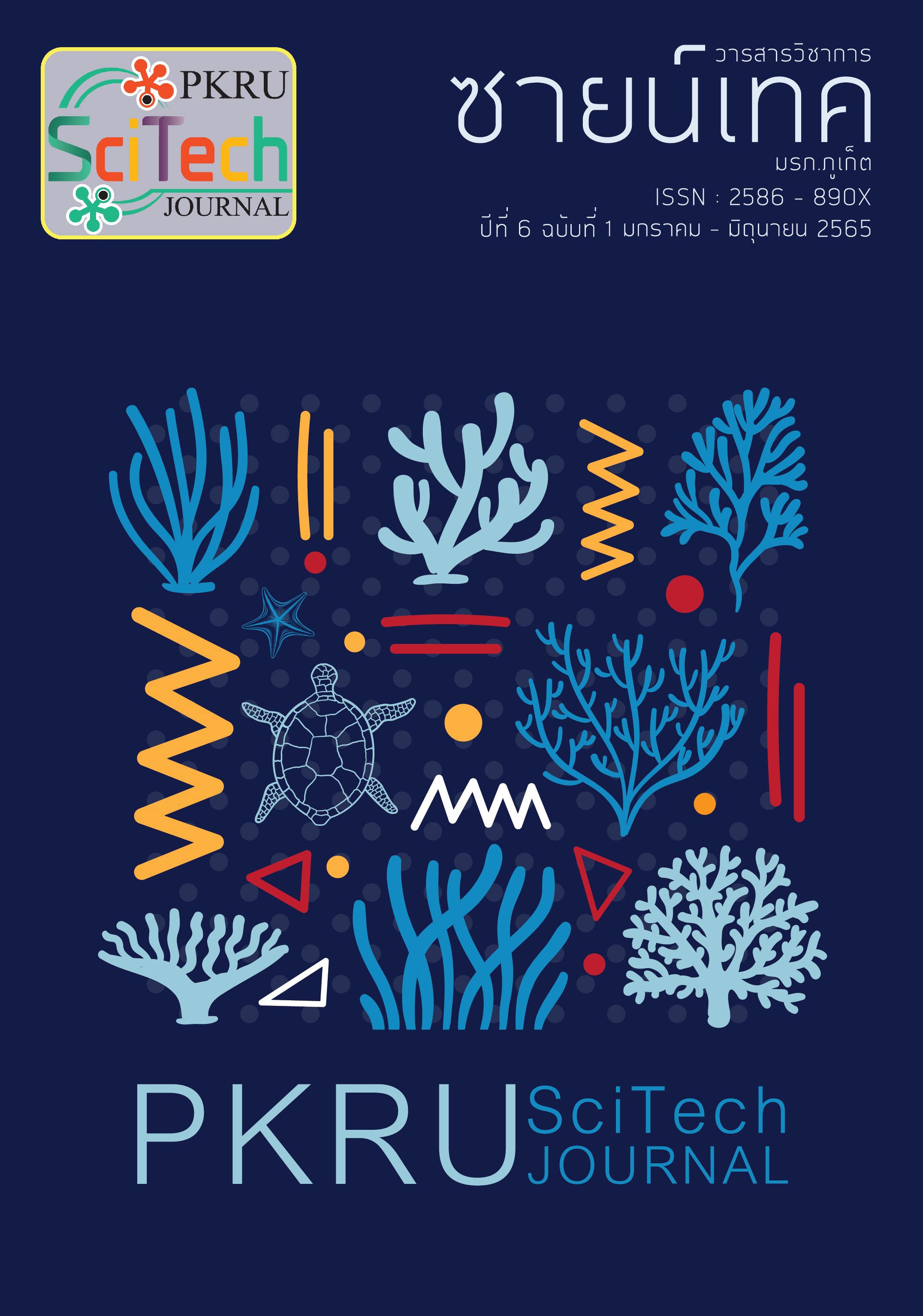Differences in Surface Orientations and Coverage of Epifauna on the Surface of Artificial Reefs in Sirinat National Park, Phuket
Main Article Content
Abstract
After installing an artificial reef is in the process of ecological succession of epifauna organisms that colonize the structure's surface as time increases. The objective of this study was to assess the composition of epifauna organisms on the surface of artificial reefs in Sirinat National Park, Phuket. Two artificial reef stations were selected to assess, which are no. 8 and no. 11. The artificial reef is eight years old. The photo quadrat method has been applied to photograph epifauna on artificial reef surfaces. The data were then analyzed and presented regarding the percentage cover of the epifauna in each group. The results of artificial reef no. 8 and no. 11 found that the epifauna covering the surface of the artificial reef were 32.50±3.05 and 31.25±2.46. There was no difference in the coverage of the epifaunas found at both stations (P=0.846). The dominant groups of epifauna in the study areas are bryozoa, bivalves, and sponges. Other less dominant groups are hydroids, hard corals, barnacles, gorgonians, and barnacles, respectively. The majority covering the vertical rather than the horizontal surface (P<0.001). Most of the surface characteristics of artificial reefs in no. 8 and no. 11 had relatively high sediment coverage, with a mean of 67.50±3.02 and 64.75±2.60. In conclusion, the artificial reefs in this study had low levels of epifauna cover. That may be due to the relatively high sediment on the artificial reef surface.
Article Details

This work is licensed under a Creative Commons Attribution-NonCommercial-NoDerivatives 4.0 International License.
- The original content that appears in this journal is the responsibility of the author excluding any typographical errors.
- The copyright of manuscripts that published in PKRU SciTech Journal is owned by PKRU SciTech Journal.
References
Baqueiro, E., & Mendez, R. (1994). Artificial reefs-an alternative to enhance Mexican littoral commercial fisheries. Bulletin of Marine Science, 55, 1014-1020.
Rhodes, R. J., Bell, M., & Pomeroy, R. S. (1994). Scuba diver expenditures associated with South Carolina's artificial reefs. Bulletin of Marine Science, 55, 1350.
Ortiz-Prosper, A. L., Bowden-Kerby, A., Ruiz, H., Tirado, O., Cabán, A., Sanchez, G., & Crespo, J. C. (2001). Planting small massive corals on small artificial concrete reefs or dead coral heads. Bulletin of Marine Science, 69, 1047–1051.
Bombace, G. (1989). Artificial reefs in the Mediterranean Sea. Bulletin of Marine Science, 44, 1023–1032.
Foster, M. S., Harrold, C., & Hardin, D. D. (1991). Point vs. photo quadrat estimates of the cover of sessile marine organisms. Journal of Experimental and Marine Biology and Ecology, 146, 193–203.
Guillen, J. E., Ramos, A. A., Martinez, L., & Sanchez, L. J. (1994). Antitrawling reefs and the protection of Posidonia oceanica (L.) Delile meadows in the Western Mediterranean Sea: demand and aims. Bulletin of Marine Science, 55, 645-650.
Gomezbuckley, M. C., & Haroun, R. J. (1994). Artificial reefs in the Spanish coastal zone. Bulletin of Marine Science, 55, 1021–1028.
Connell, J. H., & Slatyer, R. O. (1977). Mechanisms of succession in natural communities and their role in community stability and organization. American Naturalist, 111, 1119–1144.
Perkol-Finkel, S., & Benayahu, Y. (2004). Recruitment of benthic organisms onto a planned artificial reef: shifts in community structure one decade post-deployment. Marine Environmental Research, 59, 79-99.
Baynes, T. W., & Szmant, A. M. (1989). Effect of current on the sessile benthic community structure of an artificial reef. Bulletin of Marine Science, 44, 545-566.
Phongsuwan, N., Changsang, H., & Satapoomin, U. (1993). Colonization of fouling communities and associated fauna on artificial reef at Ranong Province, Thailand (pp 217–228). In The Seminar on Fisheries 1993. Phuket Marine Biological Center, Department of Fisheries.
Manoudis, G., Antoniadou, C., Dounas, K., & Chintiroglou, C. (2005). Successional stages of experimental artificial reefs deployed in Vistonikos gulf (N. Aegean Sea, Greece): Preliminary results. Belgium Journal of Zoology, 135, 209-215.
Spagnolo, A., Cuicchi, C., Punzo, E., Santelli, A., Scarcella, G., & Fabi, G. (2014). Patterns of colonization and succession of benthic assemblages in two artificial substrates. Journal of Sea Research, 88, 78-86.
Bohnsack, J., & Sutherland, D. (1985). Artificial reef research: A review with recommendations for future priorities. Bulletin of Marine Science, 37, 11-39.
Toledo, M. I., Torres, P., Díaz, C., Zamora, V., Lopez, J., & Olivares, G. (2020). Ecological succession of benthic organisms on niche-type artificial reefs. Ecological Processes, 9, 38.
Kheawwongjan, A., & Kim, D. S. (2012). Present status and prospects of artificial reefs in Thailand. Ocean and Coastal Management, 57, 21–33.
Foster, K. L., Steimle, F. W., Muir, W. C., Kropp, R. K., & Conlin, B. E. (1994). Mitigation potential of habitat replacement-concrete artificial reef in Delaware Bay-preliminary results. Bulletin of Marine Science, 55, 783-795.
Hill, J., & Wilkinson, C. (2004). Methods for ecological monitoring of coral reefs: A resource for managers (1st edition). Australian Institute of Marine Science, Townsville, 1-116.
สำนักอนุรักษ์ทรัพยากรทางทะเลและชายฝั่ง. (2557). ผลการศึกษาติดตามการเปลี่ยนแปลงของสิ่งมีชีวิตบริเวณปะการังเทียม จังหวัดประจวบคีรีขันธ์. กรุงเทพฯ: โรงพิมพ์ชุมนุมสหกรณ์การเกษตรแห่งประเทศไทย.
Glasby, T. M. (2000). Surface composition and orientation interact to affect subtidal epibiota. Journal of Experimental Marine Biology and Ecology, 248, 177–190.
Irving, A.D., & Connell, S. D. (2002). Sedimentation and light penetration interact to maintain heterogeneity of subtidal habitats: algal versus invertebrate dominated assemblages. Marine Ecology Progress Series, 245, 83–91.
Pratt, M. C. (2008). Living where the flow is right: How flow affects feeding in bryozoans, Integrative and Comparative Biology, 48, 808–822.
Wilkinson, C. R., & Vacelet, J. (1979). Transplantation of marine sponges to different conditions of light and current. Journal of Experimental Marine Biology and Ecology, 37, 91-104.


